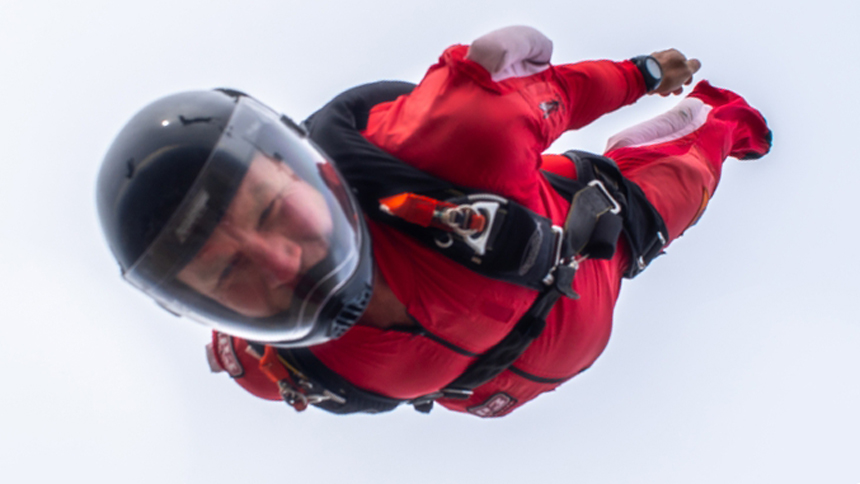Getting away from others safely to find some clear sky…

Photo is Doug Forth by Luciano Bacqué
Break offs are staged to help establish separation between waves, or rows, of people leaving the formation. If you follow the plan, the break off will be very safe. If you do not follow the plan, the break off can be dangerous.
BREAK OFFS
The key to a safe break off is everyone following the plan. If you are in the second or third wave to leave, it is important that you wait until the correct altitude. If you leave early you are changing the plan. Your correct break off and minimum/maximum deployment altitudes will be assigned and will vary depending on the size of the formation.
The break off is NOT the end of the skydive. Anticipate the break off as you would the next point.
Anticipate the break off as you would the next point”

Photo: Sequential Games 2019 over Skydive Perris by Gary Wainwright
TRACKING
The only acceptable track is a flat track. This means a very rigid position to maximize your horizontal separation. Relaxed tracks, like deltas, are not permitted. It is important to stay relative to your wave or tracking group so visuals are maintained. Be careful not only to maintain separation from those beside you, but to keep separation from groups in front of and behind you.
The only acceptable track is a flat track”
Keep in mind that tracking speeds and glide ratios vary greatly among individuals. Staying relative to those in your wave or tracking group may not mean the flattest track you are capable of.

Photo: Sequential Games over Perris by Henny Wiggers
TRACKING GROUPS
Research has shown that the safest and most effective way to achieve maximum separation of large formations is to form “Tracking Groups” which leave the formation as a team on a single specific heading, then separate from one another farther way from the formation. Each tracking group will have a leader who is responsible to set and maintain the tracking heading.
FORM YOUR GROUP FIRST, THEN TRACK
When it is time to leave the formation, form your tracking group first, then start tracking. If you leave and start tracking first, you will not be able to form a tracking group and track off will be more dangerous. When turning away from the formation to form your tracking group, turn towards the tracking leader. If you are the tracking leader, choose a comfortable turning direction and be consistent.
Forming a Tracking Group:

All jumpers turn and move toward their tracking leader

Tracking leader starts moving slowly, everyone continues moving toward tracking leader forming a close group


Stay close enough to touch
In your tracking group, you should be within 2 to 3 ft (0.6 to 1 meter) of the person you are following – if you put your arm out you should be able to touch them.
Tracking leaders set the heading
Tracking leaders, when you turn and start to track you need to start slow, look to both sides and see the tracking group forming, then begin to slowly accelerate. The tracking leader is responsible for the angle at which the tracking group leaves the formation.
Stay relative
Tracking in a group is relative work, you must find a tracking angle that everyone in your group can match. If you are a lighter person who can track very flat, you may have to relax and track a little steeper; if you are a heavier jumper you may need to work very hard to track flatter.
Tracking in a group is relative work”
Do not break early
Do not break your tracking group early, stay in your tracking group as long as you are supposed to! The longer you stay in your tracking group, the safer your break off!
Separating a Tracking Group:

Perfect separation – enough distance between jumpers for safe opening but keeping the separation angles narrow

Tracking Groups Done Correctly:

This tracking team of 10 jumpers gets safe separation from each other and the formation by tracking together on the same heading then separating farther away from the formation

The longer you stay in your tracking group, the safer your break off”

Photo by Willy Boeykens
DEPLOYMENT
As with most types of skydiving, stop your track, give a good wave off, and look up and behind you to insure safe separation before deploying. Many accidents can be avoided by taking the extra time to clear your back before deploying. THIS IS VERY IMPORTANT. THIS WILL SAVE YOUR LIFE. Take the time to look before pulling.
Take the time to look before pulling”
Diagrams courtesy of P3 Skydiving.
Big-way Bites Series
Previous article – Big-way Bites 4 – Red zone and docking
Next article – Big-way Bites 6 – Mental aspects
